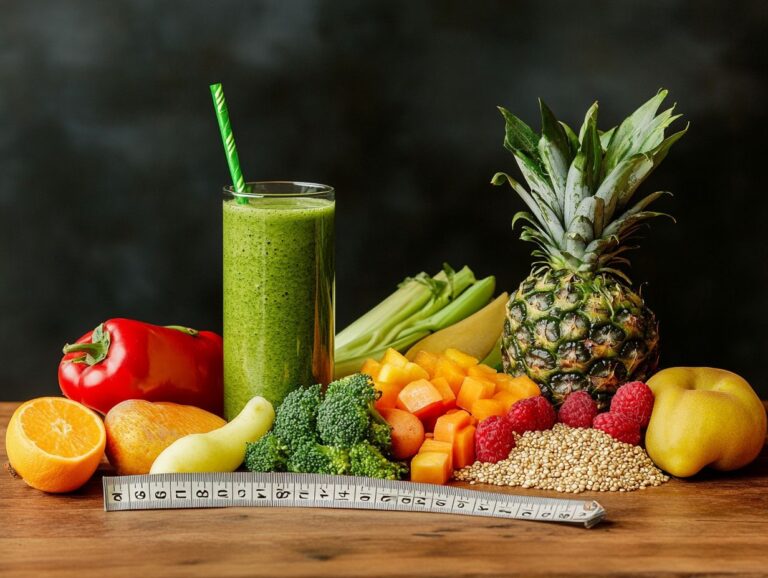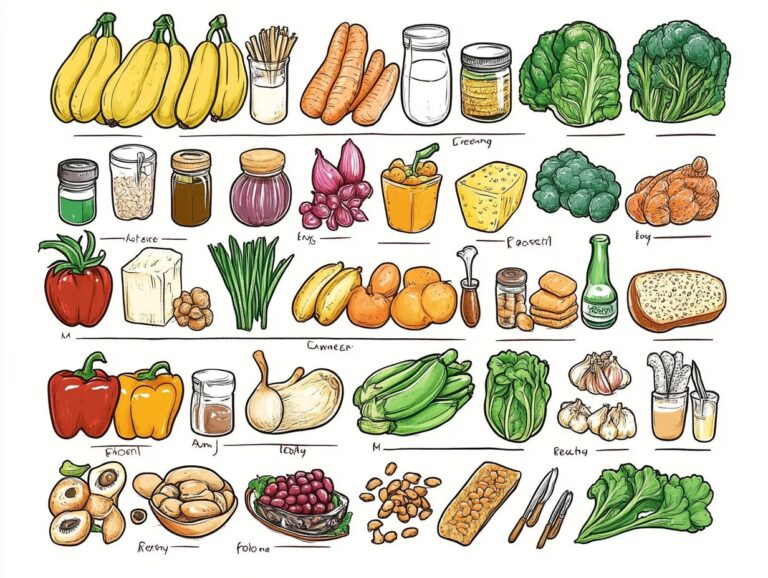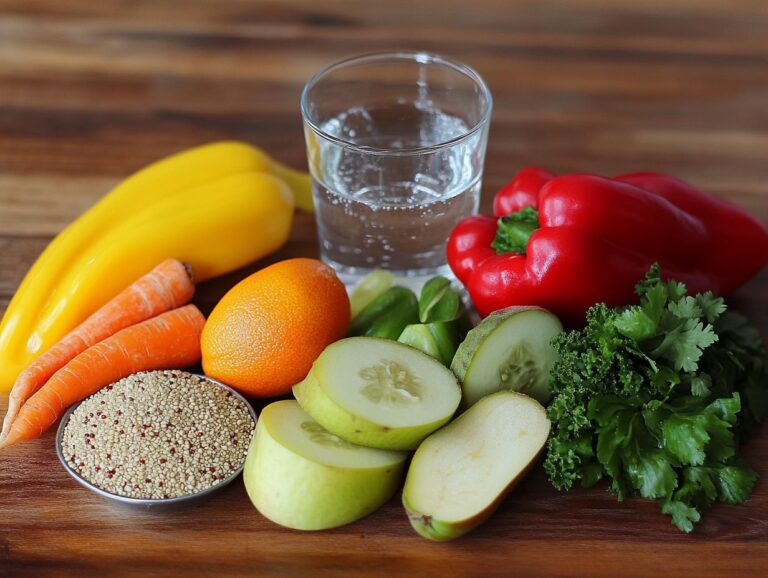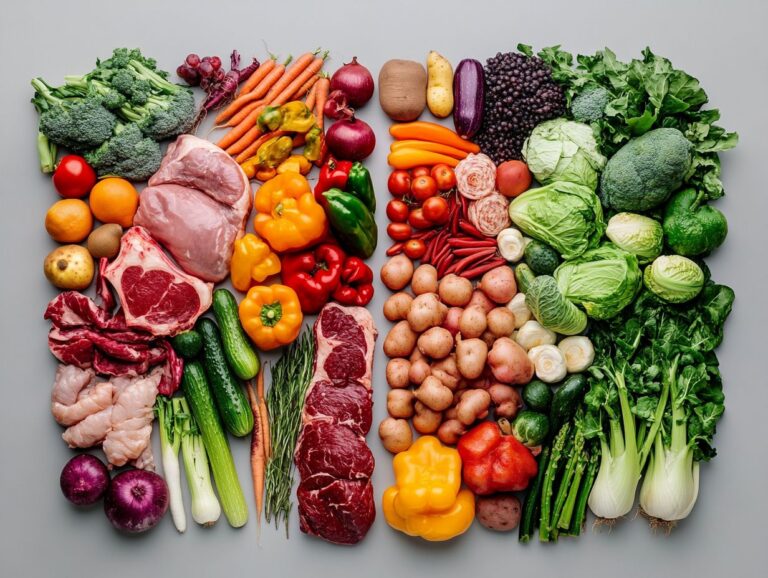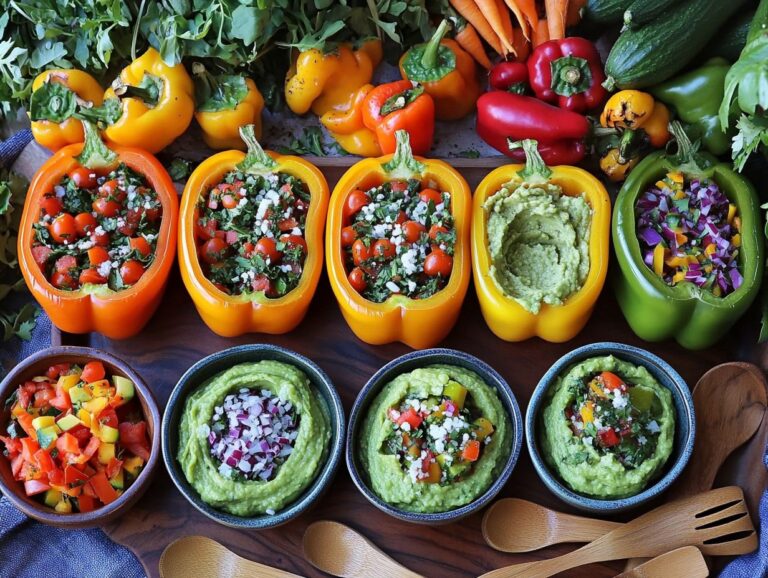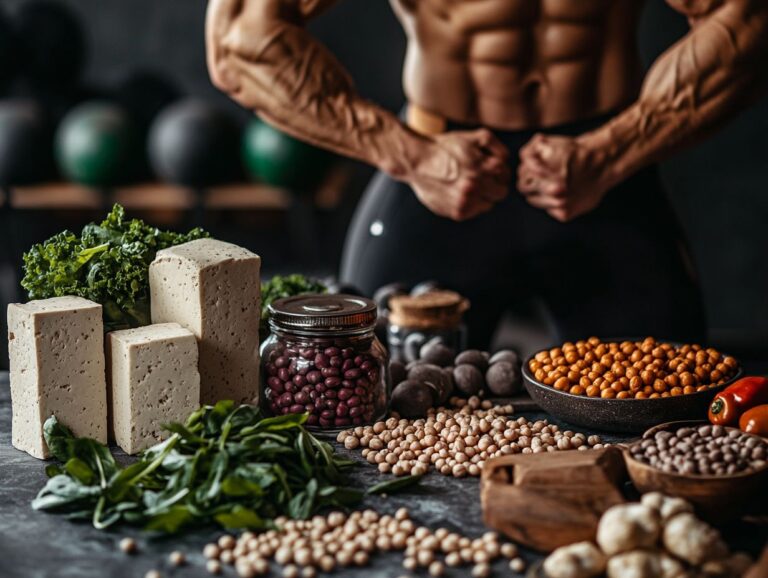Curious about how to build muscle on a vegan diet? You re not alone! Many fitness enthusiasts are discovering the power of plant-based nutrition to fuel their muscle-building goals. This article explores the fundamentals of a vegan diet, its benefits, and practical strategies to effectively gain muscle mass while staying true to a plant-based lifestyle. From calorie intake to protein sources, and even a sample meal plan, it covers everything needed to achieve fitness aspirations with plant-based power.
Key Takeaways:
- A vegan diet can provide numerous benefits, including improved heart health, weight management, and enhanced nutrient density.
- To build muscle on a vegan diet, make sure to eat enough calories to maintain a caloric surplus, focus on diverse protein sources, and incorporate a comprehensive strength training regimen.
- A sample vegan meal plan for muscle building could include protein-rich foods like tofu, beans, and quinoa for breakfast, lunch, and dinner, complemented by plant-based protein bars and protein shakes as high-protein snacks throughout the day.
What is a Vegan Diet?
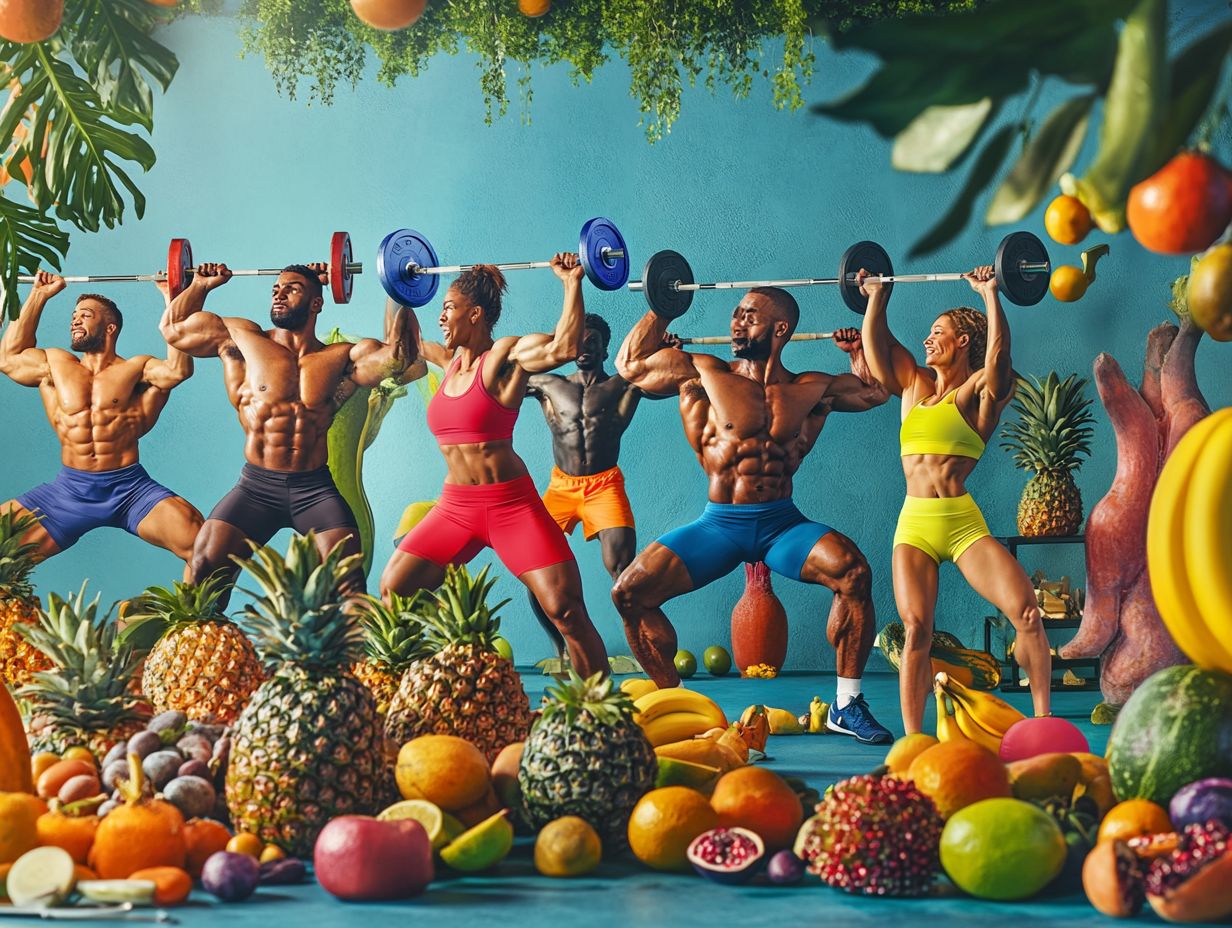 A vegan diet is a plant-based lifestyle that eliminates all forms of animal protein and other animal-derived products. Instead, it emphasizes the consumption of nutrient-dense whole foods such as fruits, vegetables, legumes, whole grains, nuts, and seeds. This dietary approach aligns with ethical considerations related to animal welfare while also promoting a healthy lifestyle by providing essential nutrients, including vitamins, fiber, antioxidants, and plant protein. The vegan diet is increasingly recognized for its potential health benefits, which include improved energy levels, effective weight management, and a reduced risk of chronic diseases.
A vegan diet is a plant-based lifestyle that eliminates all forms of animal protein and other animal-derived products. Instead, it emphasizes the consumption of nutrient-dense whole foods such as fruits, vegetables, legumes, whole grains, nuts, and seeds. This dietary approach aligns with ethical considerations related to animal welfare while also promoting a healthy lifestyle by providing essential nutrients, including vitamins, fiber, antioxidants, and plant protein. The vegan diet is increasingly recognized for its potential health benefits, which include improved energy levels, effective weight management, and a reduced risk of chronic diseases.
What Are the Benefits of a Vegan Diet?
A vegan diet enhances health by increasing nutrient density and energy levels while reducing the risk of chronic diseases through a higher intake of antioxidant- and fiber-rich foods. This lifestyle also supports effective weight management by promoting the consumption of whole, unprocessed foods that are naturally lower in calories and rich in essential nutrients. Additionally, a vegan diet contributes to better heart health, as plant-based diets tend to be low in saturated fats and cholesterol while being high in potassium, omega-3 fatty acids, and dietary fiber. The emphasis on fiber from various fruits, vegetables, and grains benefits digestive health, improving gut function and regularity. Collectively, these advantages lead to an overall enhancement in the quality of life associated with following a vegan diet.
How to Build Muscle on a Vegan Diet
You can effectively build muscle on a vegan diet by ensuring that you consume enough protein to meet your protein requirements, maintain a calorie surplus, and engage in a dedicated strength training regimen. A balanced and well-planned vegan diet should include protein-rich foods such as:
- Legumes
- Tofu
- Tempeh
- Whole grains, which are essential for meeting daily carbohydrate and fiber needs
Additionally, it is important to include a healthy amount of carbohydrates and fats to provide the essential building blocks for muscle growth.
1. Eat Enough Calories
To build muscle on a vegan diet, it is crucial to consume enough calories to achieve a caloric surplus. This surplus is essential for muscle growth and for reaching overall fitness goals. To determine your body’s calorie needs, consider factors such as age, weight, height, and activity level. Reliable methods for this assessment include using online calculators or consulting with a nutritionist. Incorporating well-chosen foods such as avocados, nuts, seeds, and legumes can help boost caloric intake without sacrificing nutritional value. Planning meals in advance and utilizing apps or meal planning tools can simplify the process of tracking daily intake. Additionally, maintaining a food diary can highlight areas where caloric intake can be increased and ensure that consumption goals are met. Both strategies, along with understanding dietary guidelines, are vital for effective muscle development and meeting fitness goals.
2. Focus on Protein Sources
High-quality protein sources are essential for muscle building on a vegan diet. Key options include legumes, tofu, tempeh, and quinoa, all of which provide the amino acids necessary for muscle repair and growth. Plus these staples, nuts and seeds such as chia, hemp, and flaxseeds contribute healthy fats, fiber, and valuable protein. For example, a cup of lentils contains approximately 18 grams of protein, helping individuals meet their daily protein intake and dietary needs. To enhance protein absorption, it is beneficial to combine these sources. Serving quinoa with black beans, for instance, improves the amino acid profile of the meal while adding a heartier texture. Incorporating a variety of plant-based proteins ensures a balanced diet, which is crucial for anyone looking to build and maintain muscle mass.
3. Incorporate Strength Training
A regular strength training program is essential for achieving strength gains and muscle hypertrophy, especially for individuals on a vegan diet who need to maximize their exercise routines to compensate for potential deficiencies. Focusing on compound exercises such as squats, deadlifts, and bench presses, which target multiple muscle groups simultaneously, is an effective way to build a comprehensive program. Incorporating bodyweight workouts or resistance bands can further enhance muscle activation and provide alternatives to traditional weights. It is important to implement progressive overload in each workout by gradually increasing resistance over time to encourage hypertrophy. Additionally, a well-rounded vegan diet that is rich in nutrients promoting muscle recovery and hypertrophy such as lentils, chickpeas, and tofu can significantly enhance the results of these training programs in building strength and muscle mass, supporting overall bodybuilding efforts.
4. Consider Supplements
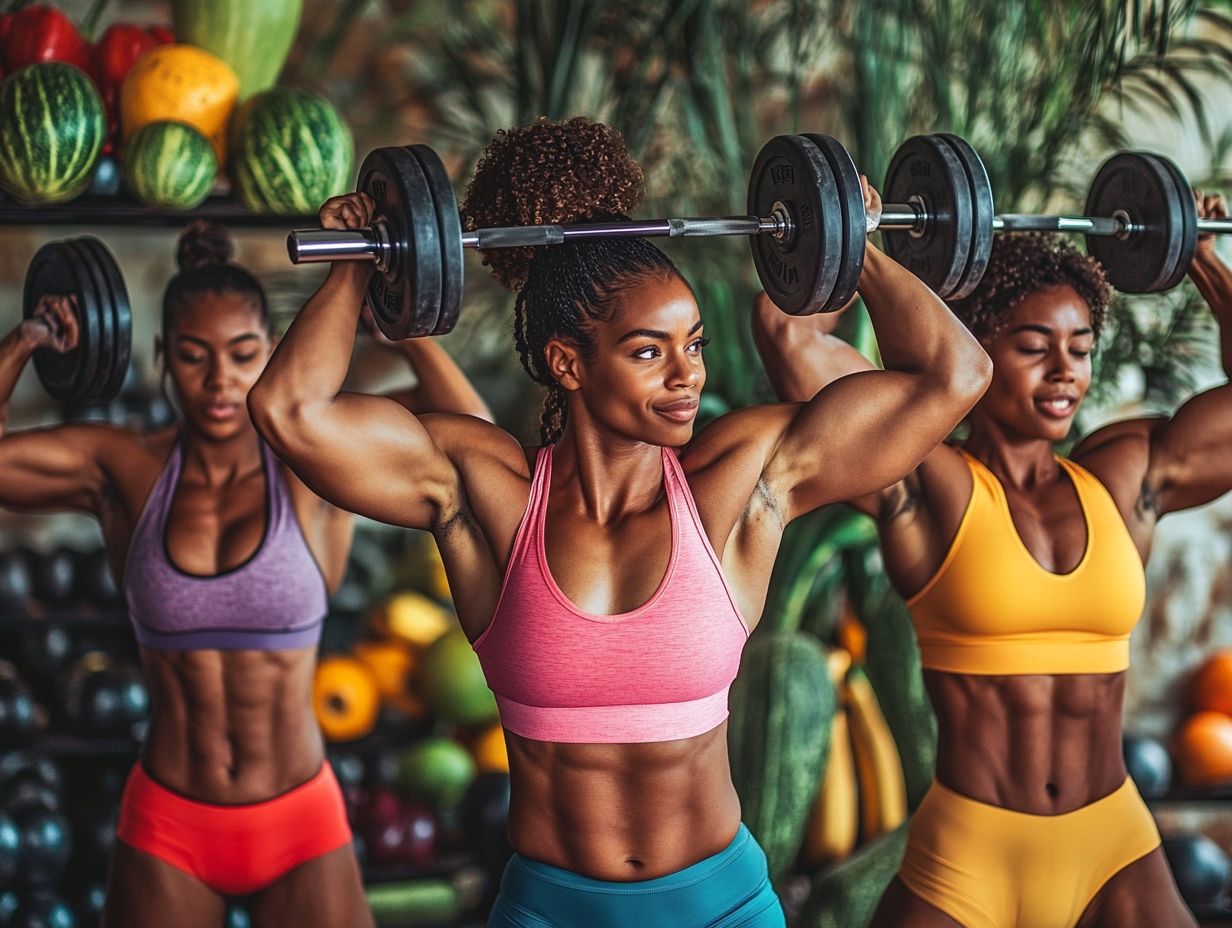 Yes, individuals on a vegan diet often use dietary supplements to address potential nutritional gaps. Common dietary supplements for vegans include vitamin B12, vitamin D, and protein powders that aid in muscle recovery and growth. Regular use of these supplements can help maintain overall health and vitality, bridging potential nutritional gaps. For instance, vitamin B12 is crucial because it is primarily found in animal products; a deficiency can lead to anemia and neurological issues. Vitamin D, often referred to as the “sunshine vitamin,” is essential for bone health and immune function, and it can be challenging to obtain sufficient amounts from plant sources alone. Additionally, protein powders derived from peas, rice, or hemp can be valuable supplements for enhancing protein intake, especially for strength athletes and active individuals seeking to maintain muscle mass and improve recovery.
Yes, individuals on a vegan diet often use dietary supplements to address potential nutritional gaps. Common dietary supplements for vegans include vitamin B12, vitamin D, and protein powders that aid in muscle recovery and growth. Regular use of these supplements can help maintain overall health and vitality, bridging potential nutritional gaps. For instance, vitamin B12 is crucial because it is primarily found in animal products; a deficiency can lead to anemia and neurological issues. Vitamin D, often referred to as the “sunshine vitamin,” is essential for bone health and immune function, and it can be challenging to obtain sufficient amounts from plant sources alone. Additionally, protein powders derived from peas, rice, or hemp can be valuable supplements for enhancing protein intake, especially for strength athletes and active individuals seeking to maintain muscle mass and improve recovery.
Sample Vegan Meal Plan for Muscle Building
A well-structured vegan meal plan for muscle building should emphasize protein-rich meals. By incorporating whole foods and effective meal prep strategies, vegans can ensure they meet their nutritional needs and achieve their fitness goals while adhering to recommended dietary intake.
Breakfast
A high-protein breakfast can include options such as a tofu scramble, protein smoothies, or overnight oats topped with nuts and seeds, which help start the day with essential muscle-building nutrients. Incorporating these foods into your breakfast ensures adequate energy levels and aids in muscle recovery, making them an excellent choice for anyone who exercises regularly. For easier time management, overnight oats can be prepared in a mason jar for convenient on-the-go consumption, while smoothies can be made in batches, frozen, and blended each morning for a quick and nutritious option. A tofu scramble can also be prepared in advance and reheated as needed, simplifying nutrition education and meal plans. Proteins serve as the building blocks of amino acids, and including protein-rich foods in the morning simplifies the process of meeting the daily recommended intake. Consuming high-protein breakfasts provides sustained energy and muscle nutrients throughout the day.
Lunch
Lunches that are rich in plant-based protein, such as quinoa salad with chickpeas or a hearty lentil soup, can enhance feelings of fullness and support muscle growth. These meals not only contribute to the recommended daily protein intake but also provide essential nutrients found in various legumes, grains, and vegetables. Incorporating additional ingredients like edamame, black beans, or hemp seeds can further boost the protein content of your meals, supporting protein timing. Planning your lunches is a great way to streamline your week and ensure easy access to nutrient-rich foods. Whether in the form of colorful bowls or wraps, having a meal plan helps you stay on track with your eating goals and promotes overall well-being.
Dinner
Dinner recipes that promote muscle repair and growth typically feature high-protein meals. Examples include black bean burgers served on whole grain buns and stir-fried tofu with mixed vegetables. Other nutritious options for an exercise and recovery diet consist of quinoa salad with chickpeas, cucumbers, and lemon-tahini dressing, lentil stew with carrots and celery served over farro, and grilled salmon paired with a barley salad containing tomatoes and parsley.
Quinoa Salad with Chickpeas, Cucumbers, and Lemon-Tahini Dressing
Ingredients:
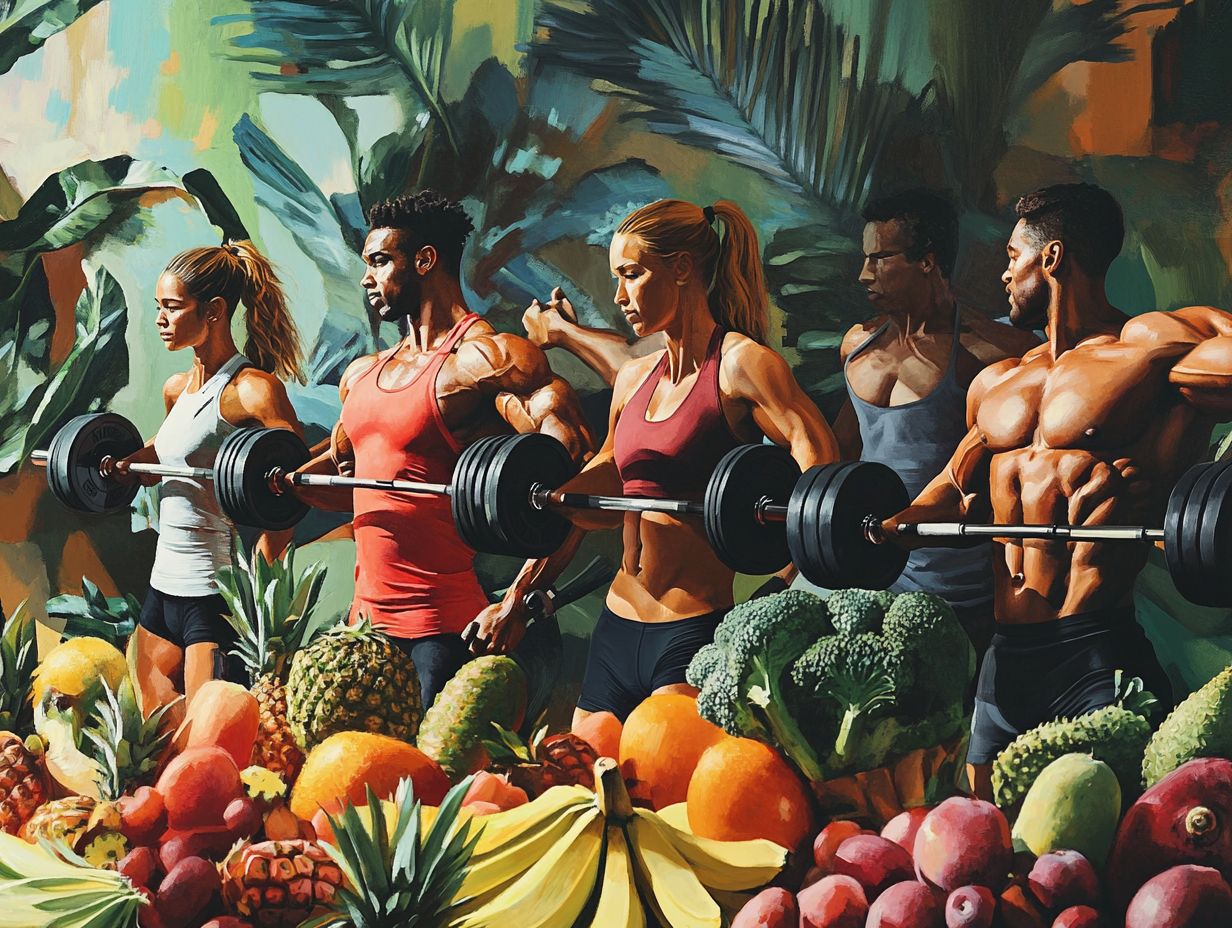
- 1 cup uncooked quinoa
- 1 cups water
- 1 cups canned chickpeas, drained and rinsed
- 1 cucumber, diced
- 1 cup diced bell pepper
- cup diced red onion
- cup diced tomatoes
- cup crumbled feta cheese
- 1 cup fresh parsley, chopped
Lemon-Tahini Dressing:
- 3 tablespoons tahini (a great source of plant protein)
- 3 tablespoons olive oil
- 1 tablespoon lemon juice
- 2 tablespoons red wine vinegar (helps in muscle repair)
- 1 tablespoon honey
- Salt and pepper to taste
Instructions (Step-by-Step Meal Prep):
- Rinse the quinoa in a fine-mesh strainer under cold water.
- In a saucepan, combine the rinsed quinoa and water. Bring to a boil, cover, and reduce heat to low. Simmer for 15 minutes until all the water is absorbed.
- Remove from heat and let it sit for 5 minutes before fluffing with a fork.
- In a large bowl, combine the cooked quinoa, chickpeas, cucumber, bell pepper, red onion, tomatoes, feta cheese, and parsley.
- To prepare the dressing, whisk together tahini, olive oil, lemon juice, vinegar, honey, salt, and pepper in a small bowl. Drizzle the dressing over the salad and toss to combine.
- Serve immediately or refrigerate for up to 2 days. This meal is perfect for meal prep and ensures you have protein-rich meals ready to support your dietary intake and fitness goals.
Nutritional Values (Per Serving) (Highlighting Nutritional Benefits):
- Calories: 353
- Protein: 13 g
- Carbohydrates: 49 g
- Sugar: 8 g
- Fiber: 9 g
- Total Fat: 14 g
- Saturated Fat: 3 g
- Cholesterol: 9 mg
- Sodium: 226 mg
Lentil Stew with Carrots and Celery (A High-Protein Dish)
Ingredients:
- 1 cup lentils, rinsed
- 4 cups vegetable broth
- 2 medium carrots, chopped
- 1 celery stalk, chopped
- 1 onion, chopped
- 3 garlic cloves, minced
- 1 teaspoon cumin
- 1 teaspoon paprika
- 2 bay leaves
- Salt and pepper to taste
Instructions:
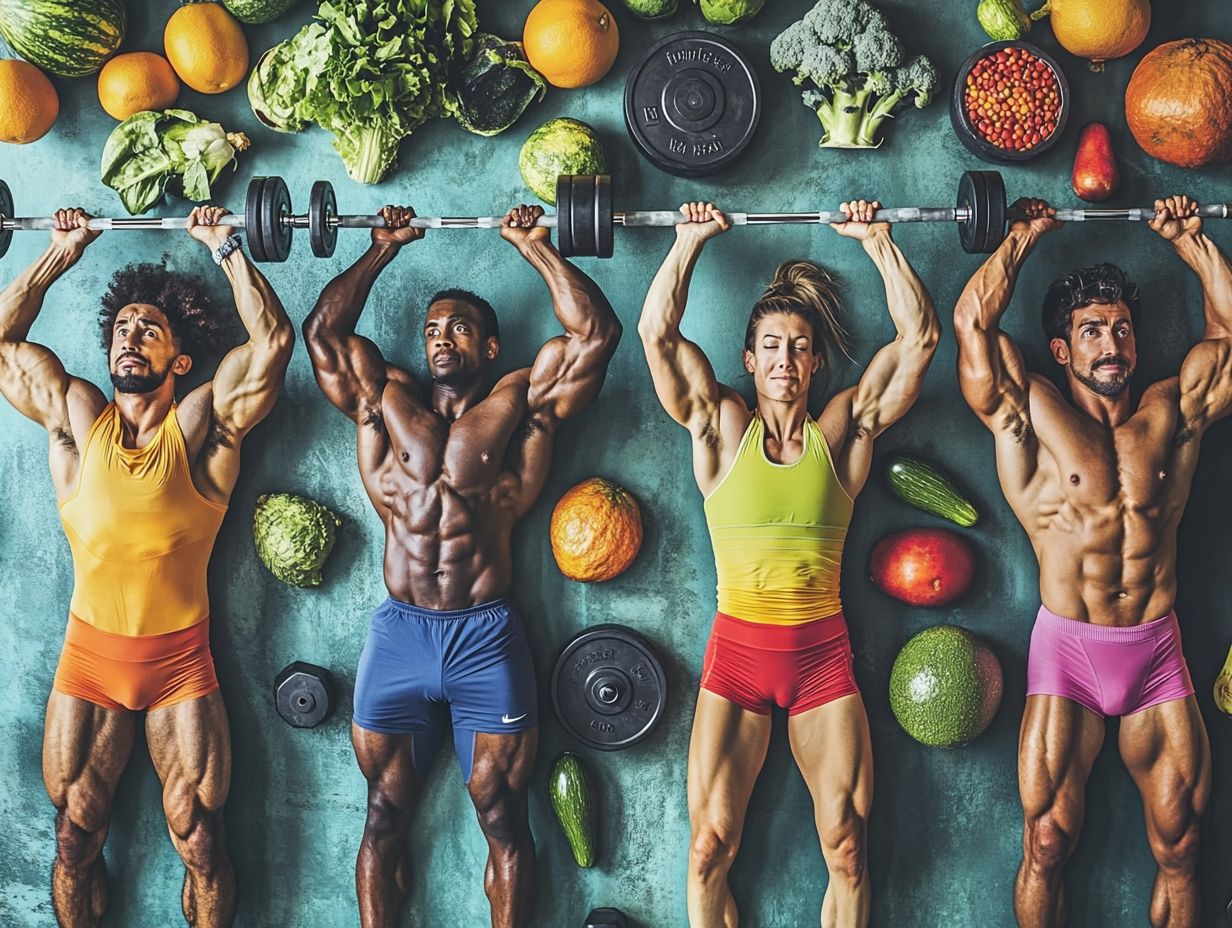
- In a large pot, saut the onions, garlic, carrots, and celery until softened. This step helps in enhancing the nutrient density of the dish.
- Add lentils, vegetable broth, cumin, paprika, bay leaves, salt, and pepper. Bring to a boil, then reduce heat and simmer for 30-40 minutes until the lentils are tender.
- Remove bay leaves before serving.
Nutritional Values (Per Serving):
- Calories: 204
- Protein: 12 g
- Carbohydrates: 35 g
- Sugar: 4 g
- Fiber: 11 g
- Total Fat: 1 g
- Saturated Fat: 0 g
- Cholesterol: 0 mg
- Sodium: 575 mg
Grilled Salmon with Barley Salad (A Nutrient-Rich Food Combination)
Ingredients:
- 2 salmon fillets
- 1 cup pearl barley
- 3 cups vegetable broth
- 2 tomatoes, chopped
- 2 tablespoons fresh parsley, chopped
- 2 tablespoons lemon juice
- Salt and pepper to taste
Instructions:
- Rinse barley under cold water.
- In a saucepan, combine barley and vegetable broth. Bring to a boil, cover, and reduce heat to low. Simmer for 30 minutes until tender.
- Grill salmon fillets over medium heat for 6-8 minutes per side.
- Serve the salmon over the barley salad, topped with tomatoes, parsley, and lemon juice.
Nutritional Values (Per Serving):
- Calories: 359
- Protein: 25 g
- Carbohydrates: 36 g
- Sugar: 2 g
- Fiber: 5 g
- Total Fat: 12 g
- Saturated Fat: 3 g
- Cholesterol: 67 mg
- Sodium: 38 mg
Snacks
Eating healthy snacks throughout the day is essential for maintaining energy levels, meeting protein requirements, and supporting muscle building and strength training. Healthy snack options that are high in protein include:
- Protein bars (try plant-based protein bars)
- Hummus with cut vegetables
- Mixed nuts (rich in healthy fats)
- Dark chocolate-covered almonds
- Roasted chickpeas
These quick meals and snacks can be prepared using plant-based ingredients, ensuring that individuals with dietary restrictions have access to delicious options that cater to their specific dietary needs and fitness goals. For instance, fruits can be blended with plant-based yogurt to create a quick smoothie, or quinoa can be transformed into a vibrant salad with various colorful vegetables. Dark chocolate-covered almonds or roasted chickpeas serve as satisfying crunchy snacks, rich in protein and fiber content. By incorporating high-protein snacks, you can effectively curb hunger, maintain adequate energy levels, and support muscle growth and repair throughout a busy day. Consider adding protein shakes or protein powders to your snack options for an extra protein boost.
Common Misconceptions about Building Muscle on a Vegan Diet (Debunking Myths)
Common misconceptions about building muscle on a vegan diet include the belief that it is impossible to build muscle or gain strength without consuming animal products, the notion that protein requirements cannot be adequately met through a vegan diet, and the assumption that significant muscle growth cannot be achieved without animal protein sources. However, many strength athletes, including Arnold Schwarzenegger and Venus Williams, have successfully built muscle on a vegan diet by focusing on protein intake, plant protein sources such as tofu, tempeh, and legumes, and incorporating nutrient-rich whole foods into their meal plans.
